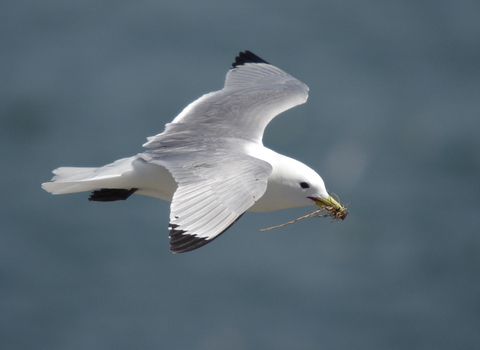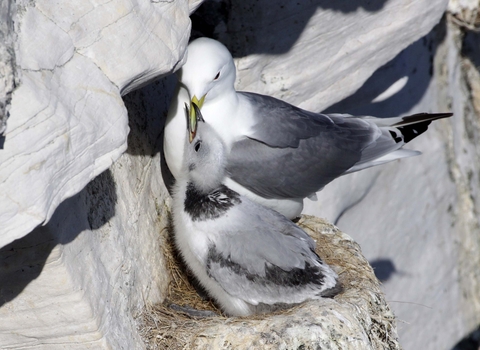
Kittiwake ©James Rogerson

Kittiwake ©Margaret Holland
Kittiwake
Scientific name
Rissa tridactylaWhen to see
February to OctoberSpecies information
About
The kittiwake is our most sea-loving gull, only turning up inland on odd occasions and spending winter out on the Atlantic. A medium-sized, elegant and gentle-looking gull, it eats fish, shrimps and worms, and does not scavenge at landfill sites like other gulls. It nests in colonies on clifftops and rock ledges from February until August; there are 380,000 pairs in the UK.How to identify
The kittiwake is easily identifiable at its clifftop nesting colonies, particularly when you hear its 'kittiwake' call. Adults are silvery-grey above and white below, with a white head and black wingtips. Young birds have a black 'W' across their wings and back, a black neck-collar and a black band on their tail.Distribution
Nests on coastal cliffs. Can be seen around most of our coasts during migration.In our area
The Isles of Scilly are home to breeding populations of thirteen species, including kittiwakes with around 20,000 birds in all. Sadly, the Isles of Scilly are on the edge of their southern range and kittiwake numbers are in sharp decline, with just a handful of breeding pairs every year. The best time to enjoy our seabirds is the spring and summer, from April to July, when you'll see the biggest diversity. Fulmars hang on the wind off their cliffs, shags stand sentry on the rocks, puffins, guillemots and razorbills hang out on their islands, whilst flocks of gannets (which don’t breed on Scilly) feast on the small fish that are shoaling around the islands. Gulls swoop around the harbour and bays and shout out their noisy calls over Hugh Town.
Did you know?
Studies of kittiwake colonies have shown that birds at the centre of the colony are established pairs, having been together for several years. They tend to be more successful at raising their chicks than new pairings as they share the duties of guarding the nest more equally, meaning that both parents can feed well without the chicks being left alone.The Isles of Scilly are home to breeding populations of thirteen species, including kittiwakes with around 20,000 birds in all. Sadly, the Isles of Scilly are on the edge of their southern range and kittiwake numbers are in sharp decline, with just a handful of breeding pairs every year. The best time to enjoy our seabirds is the spring and summer, from April to July, when you'll see the biggest diversity. Fulmars hang on the wind off their cliffs, shags stand sentry on the rocks, puffins, guillemots and razorbills hang out on their islands, whilst flocks of gannets (which don’t breed on Scilly) feast on the small fish that are shoaling around the islands. Gulls swoop around the harbour and bays and shout out their noisy calls over Hugh Town.
